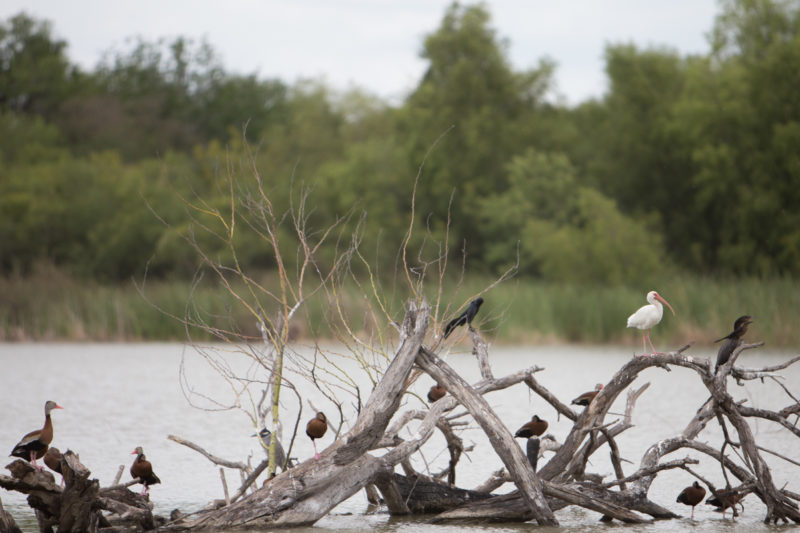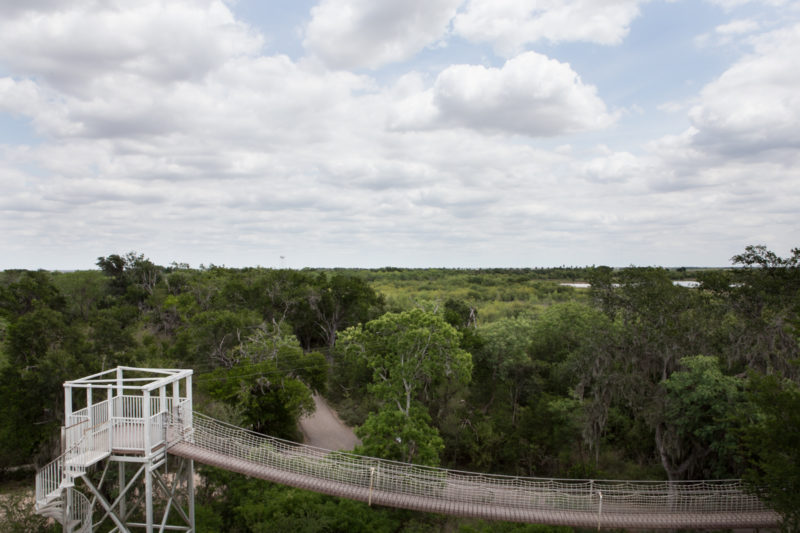In South Texas, Border Wall Debate Includes Impact on Wildlife
By Alvaro Céspedes
Reporting Texas

Various bird species gather at the Santa Ana National Wildlife Refuge in the Rio Grande Valley. Lynda Gonzalez/Reporting Texas
ALAMO — The debate over President Donald Trump’s campaign promise to build a wall along the U.S.-Mexico border has focused on how such a barrier would affect people in the two countries.
But in the Lower Rio Grande Valley, conservationists and tourism officials also worry about the impact on bobcats, beavers, otters, ocelots and birds. While politicians debate the pros and cons of the wall, a wide array of wildlife crosses the border every day to enter the Santa Ana National Wildlife Refuge, on the Rio Grande River in South Texas.
The Santa Ana refuge is a 2,088-acre protected area, created by the federal government in 1943 that extends right up to the Rio Grande. The Mexican state of Tamaulipas is just a few dozen yards away across the river.
The area is a tropical oasis, echoing with the chatter of birds in the palm trees and home to dozens of types of wildlife. But Trump’s proposed “big and beautiful” 30-foot high concrete wall could have a dramatic effect on the animals who live in or visit the refuge, and to residents who depend on the tourism it attracts.
The area has a rich ecosystem, experts say, due to geography: It stretches along the southeast region of the Texas-Mexico border, where the Gulf of Mexico, the Great Plains and the Chihuahuan Desert meet. Hundreds of species can be found along the more than 14 miles of walking trails in the refuge.

The refuge features a rope bridge connecting two observation platforms, which give visitors a panoramic view of the area. Lynda Gonzalez/Reporting Texas
Marie Santiago has been a local teacher of environmental science and biology for 44 years. She is leading a high school class to check the phosphate and pH levels in the water of one of the refuge’s many small lakes, fed by the Rio Grande, to study the growth of algae.
“Wildlife [need] to be able to move across the river. You build a wall there, it’s gonna cut that off. They’re not gonna be able to migrate,” she said, shaking a test tube filled with water from the Rio Grande. “We even got snakes that go across the river, so [if] you’ve got a barrier there? That’s gonna stop them.”
The Lower Rio Grande Valley, technically a delta, is an ecotourism hotspot attracting not only Texans but also national and international visitors attracted by its wildlife, nice weather and natural beauty. Settlers in the early 20th Century, hoping to attract people and investment, christened the area “the Magical Valley.”
Since he became president, President Trump’s wall proposal has run into its own barriers. Chief among them are questions of cost, who would pay and whether there’s enough support in Congress and among the American people. The president had demanded that Congress include money for the wall in the budget measure it will submit this week, but backed off when lawmakers balked.
While the fate of the wall remains unclear, that hasn’t kept Gerardo Ceballos from worrying about the possible threat to animals and nature. He teaches in the Department of Ecology at the National Autonomous University of Mexico and is an expert on the region of which Santa Ana is part.
“For many species, the problem with the wall is simply that its populations will remain separated in two, [becoming] more vulnerable to extinction,” he said in Spanish during an interview. “Species such as the ocelot, of which there are very few individuals left in the United States, are prone to disappearing completely from the U.S. if there is a wall, as they are kept away from the individuals that migrate from Mexico.”
Currently, there are only two populations of ocelots left in the wild in the Valley region; both are on the American side of the border, and total between 80 and 120 individuals. Ceballos also is worried about how construction might scare away the few ocelots left.
The Santa Ana refuge received more than 200,000 visitors in 2015, the majority of them birdwatchers. The park is home to 400 species of birds and half of all butterfly species that can be found in North America, such as the rare dark kite swallowtail and the orynithion swallowtail.
“If you count the butterfly species and the bird species, among the 550 National Wildlife Refuges in the United States, Santa Ana has the most. Some people call it ‘the jewel in the crown of the refuge system.’ It’s a very special place,” said Keith Hackland, a local hotel owner.
Hackland, a native of South Africa and a bird and butterfly watcher, started the Alamo Inn Bed & Breakfast in 1999. The property is a preferred spot for the crowds of nature enthusiasts that herd into the Valley all year round, making up 99 percent of the hotel’s guests.
Hackland also is the treasurer of the Alamo Chamber of Commerce and has helped form various local organizations to promote nature tourism and conservation. It was hard to hear his voice clearly over the phone, because of the background noise from all the birds. “We have people coming from 40 different countries and from all the U.S. states to stay with us,” he said.

Marie Santiago has been coming to the refuge since childhood and said it’s a special place to her that the wall could damage. “Wildlife need to be able to move across the river,” she said. “You build a wall there, it’s going to cut that off.” Lynda Gonzalez/Reporting Texas
Santa Ana also contributes to the economy of Cameron and Hidalgo counties, where it is located. It generated a total employment income of $1.2 million and $892,000 in tax revenue in 2014.
The U.S. Fish and Wildlife Service, which manages the refuge, declined to be interviewed for this article, but said in a statement, “Any assessment of the potential impacts of a U.S.-Mexico border wall on threatened and endangered wildlife would be made through the formal consultation process under Section 7 of the Endangered Species Act, once initiated by the federal action agency involved. We have not received a request for such a consultation from any agency.”
Liliana Izaguirre and Janette Vázquez are students at the University of Texas-Rio Grande Valley. On a recent day, they hiked in the Santa Ana refuge for the first time, making use of its well-known rope bridge that connects two observation towers, from which visitors can see the Río Grande and even Mexico.
“It’s relaxing here, it’s calm… The trees are so pretty here. It would be an impact to come in here and see a wall,” Vázquez said.
Opinions are divided on the wall in border areas such as the refuge, with some residents and local officials saying the wall is needed to curb illegal immigration.
The Rio Grande Valley is one of the country’s leading points for illegal crossings, and landowners object to immigrants crossing their property, often at night.
Numbers have decreased since President Trump entered the White House with a tough stand against undocumented immigrants and increased arrests of those caught inside the U.S. In March, federal agents apprehended 16,000 immigrants along n the Southwest border, a 64 percent decrease from a year earlier.
The supporters include Elliott Smith, 74, originally from Vermont and a volunteer at the Santa Ana refuge. He said the wall is an option worth trying to reduce illegal immigration. He’s less worried about how it would affect wildlife.
“Anything with wings will go over it… Mother Nature will figure it out,” he said.
In contrast, Marie Santiago is apprehensive. The refuge “ is very endearing to me,” she said. “I’ve been coming here since I was a little girl. It’s a very special place. I don’t want to see it go to hell.”